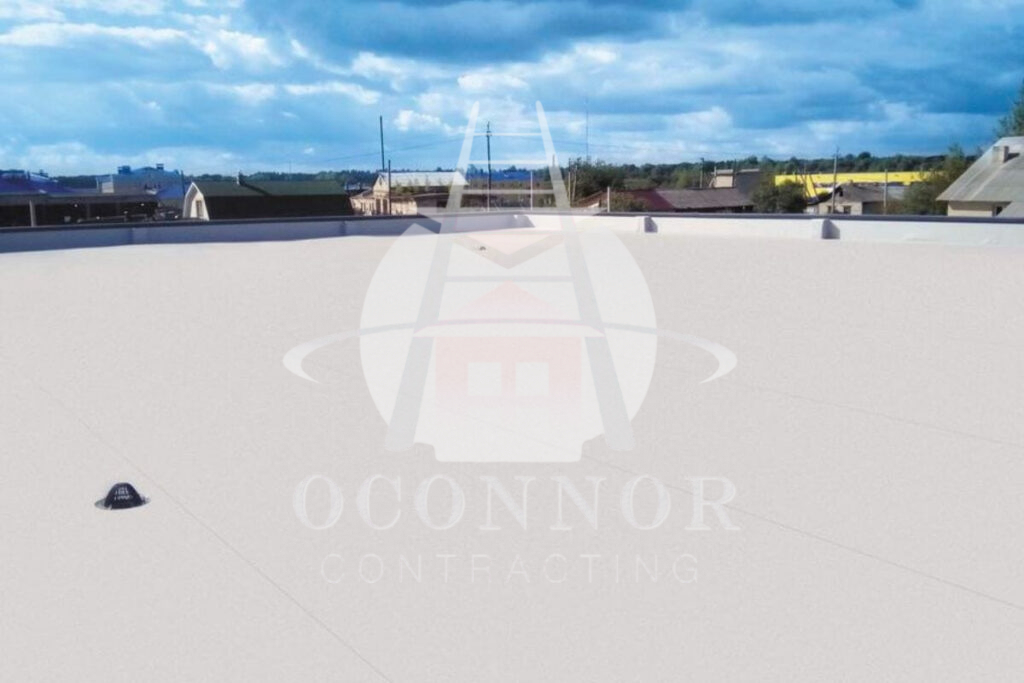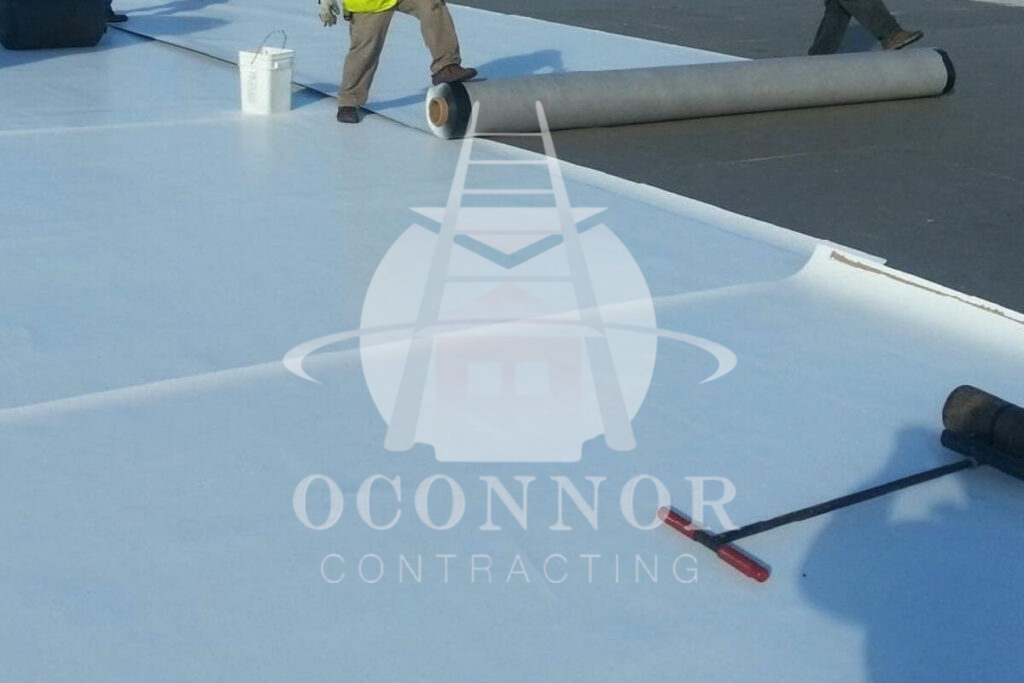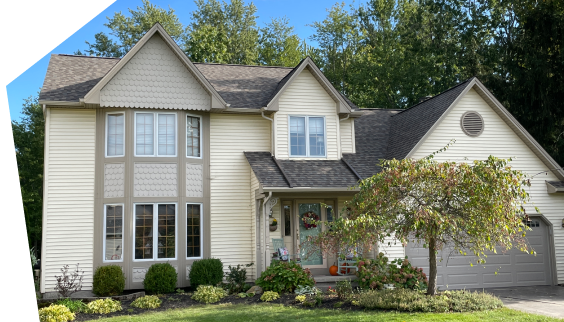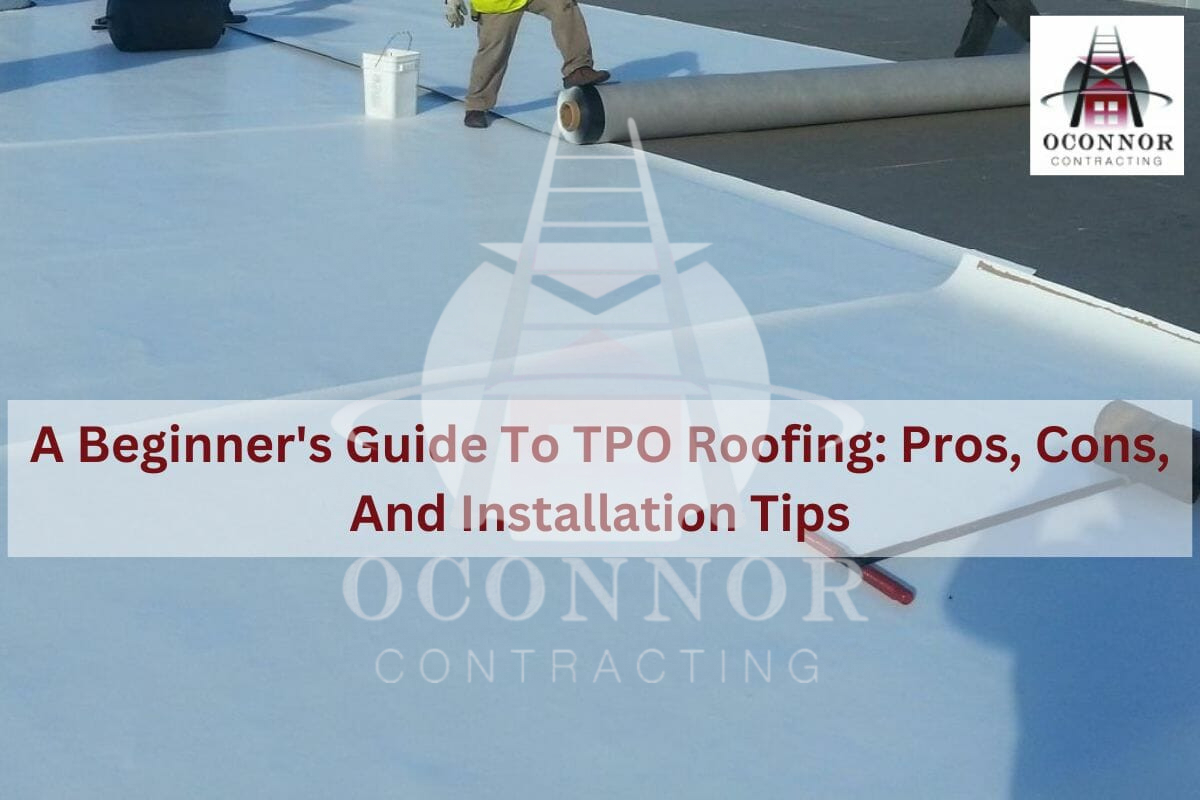Do you need a new roof for your building? A TPO roof may be just what you need. TPO is a relatively new product but has become popular due to its sturdy, durable, and energy-efficient properties.
At OConnor Contracting, we’re here to help you discover if TPO roofing is right for you. In this article, we’ve explained everything you need to know about TPO roofs, from their pros and cons to composition and installation.
What Is TPO Roofing?
TPO stands for thermoplastic olefin, and it’s a single-ply roofing membrane made from a blend of rubber, plastic, and other materials. This roofing material is suitable for flat or low-slope roofs, especially for commercial and industrial buildings.
Since TPO is a new development in the roofing industry, many manufacturers are still experimenting with it. This means that it’s essential to choose a reputable manufacturer to get a good quality TPO membrane and get the best out of your roof.
Let’s learn the benefits of a TPO roof for your building.

Advantages Of A TPO Roofing System
From high resistance power to cost-effectiveness, TPO roofs have a lot to offer. Here are 14 benefits of having a sturdy TPO roof on your building:
Energy Efficient
TPO is a highly reflective material that can reflect up to 78% of the sun’s heat away from a building. This reduces the amount of heat absorbed by a building, resulting in lower energy costs associated with air conditioning. Additionally, TPO roofing is available in various colors, including white, which helps to increase its reflectivity and energy efficiency even further.
Eco-Friendly
TPO membranes are made from recyclable thermoplastic material. At the end of its lifespan, the membrane can be recycled and used to produce other products, reducing waste, and promoting sustainability. Additionally, TPO roofing does not release toxic fumes during installation and contains no hazardous chemicals or materials, such as chlorine. This makes it safe for both humans and the environment.
Lightweight
TPO is a lightweight material that can reduce the overall weight on a roof’s structure. This is particularly beneficial for older buildings with weight restrictions or complex roof designs that require a lighter roofing option.
Durable
TPO is a highly durable material that can withstand harsh weather conditions, including strong winds and hail. It is also resistant to cold temperatures, making it an ideal roofing option for many parts of the country.
Versatile
TPO membranes can be installed on a wide range of roof shapes and sizes. It is also available in a range of thicknesses and widths, allowing it to be customized to fit any building design.
Low-Maintenance
TPO roofing membranes require minimal maintenance and are easy to clean and repair. Its smooth surface prevents dirt and debris buildup, and any damage can be easily repaired with a patch or adhesive.
Reflective And UV Resistant Surface
TPO is highly resistant to UV rays, which can cause other roofing materials to deteriorate or fade in color over time. TPO’s UV resistance helps it to maintain its reflective property and appearance over time.
Resistant To Chemicals
TPO is resistant to many chemicals, including oils, acids, and grease. This makes it an ideal choice for industrial or commercial buildings that handle chemicals or have chemical emissions.
Resistant To Mold And Mildew
TPO roofing membranes are resistant to mold and mildew, which can be common in areas with high levels of humidity. This helps increase the lifespan of the roofing system and reduces the risk of mold and mildew growth on the ceilings too.
Fire-Resistant
TPO is highly fire-resistant and comes with a Class A fire rating, which is the highest rating among roofing materials. Having fire resistance helps prevent the spread of fires in an emergency and provides additional safety for building occupants.
Flexible
TPO roofing is a flexible material that can expand and contract with temperature changes. This flexibility helps to prevent cracking and splitting, which is common in more rigid roofing materials.
Excellent Seam Strength
TPO roofing has excellent seam strength, which helps to prevent leaks and ensures a strong seal. When the seams are heat-welded together, it creates a strong bond that is highly resistant to wind uplift and water infiltration.
Fast Installation
TPO roofs can be installed quickly and efficiently, which helps reduce a roofing project’s overall cost. TPO membrane rolls can be cut to fit specific dimensions of a roof, which also saves time during installation, particularly for large roofing projects.
Strong Warranty
The industry’s leading manufacturers, like Carlisle Syntec, offer strong warranties ranging from 20 to 30 years for their TPO roofs. This warranty gives building owners peace of mind, knowing that their roof is protected against manufacturing defects. Additionally, you may also get extended warranties that can cover installation and labor costs in the event of a roofing failure.
Now that you know the benefits of a TPO roof, it’s time to know about the features that may cause some people to choose another roofing material.
Potential Drawbacks Of TPO Roofing Systems
Drawbacks and concerns will vary according to your needs and preferences, but here are some of the most common concerns that property owners have about TPO roofing membranes:
Less Proven Track Record
While TPO has been used in the roofing industry for three decades, it still has a shorter track record than other roofing materials, such as EPDM and metal roofing. This means that there may be more uncertainty about how a particular TPO membrane will perform over a long period of time, particularly in extreme weather conditions. But the good part is, you can easily overcome this fear of uncertainty by choosing an industry-leading manufacturer.
Heat Performance Concerns
While TPO membranes are highly reflective and energy-efficient, they can sometimes struggle to perform well under extreme heat conditions. In some cases, TPO roofing may experience heat-related issues, like blistering and warping, particularly if it is not installed correctly or is often exposed to high temperatures. Building owners and roofing contractors should ensure that the roof is installed properly and is well-ventilated to prevent heat buildup.
Foot Traffic Limitations
Like any other single-ply roofing membrane, the TPO roofing system is not designed to handle heavy foot traffic or sharp objects. Walking on a TPO roofing membrane can cause punctures or tears. It is essential to limit foot traffic on TPO roofs and provide protective measures such as walkway pads or pathways to prevent damage to the roof. Additionally, any work on the roof, such as HVAC maintenance or repairs, should be performed by trained professionals who are equipped to work safely to avoid damaging the roofing material.
After evaluating the benefits and drawbacks of TPO roofing, it’s crucial to ensure the installation is done correctly. The techniques used and installation quality are among the biggest factors that affect the functioning and durability of a TPO roof. Whether you’re a project manager or business owner, these tips will help you get the job done right.
Let’s delve into some critical installation aspects of TPO roofing systems.
TPO Roof Installation Tips
In this section, we’ll discuss three crucial tips for installing a TPO roof, including product quality, installation techniques, finding a contractor, and more. By following these tips, you can ensure that your roof is installed correctly and efficiently, offering a high return on investment.
1. Find An Experienced Roofing Contractor
Look for a commercial roofing contractor with experience installing TPO roofing systems. Check their references, portfolio, and reviews before hiring them. Make sure they are local as well since this ensures they are familiar with the local building codes and weather conditions in your area. Also, make sure that the roofing contractor you hire is licensed and insured. This will ensure that you’re protected in case of any accidents or damage during installation.
2. Choose High-Quality Products
One of the most critical factors in ensuring a successful installation is using high-quality roofing products. Buy the membrane and other roofing materials from a reputable supplier or manufacturer.
3. Choose An Installation Method

There are three main techniques for installing TPO roofs, each with a different set of pros and cons. The suitability of the technique depends on the specific requirements of the roofing project.
Mechanical
The mechanically attached technique is one of the most popular methods for installing TPO roofing systems. With this method, the TPO membrane is secured to a roof deck using screws or plates that are driven into the deck at regular intervals. This technique does not require the use of adhesives, which can eliminate the need for solvent-based chemicals. However, screws can become a source of leaks in the future due to the way they are driven through the membrane, and from small holes that may become larger in extreme weather conditions.
Fully Adhered
The fully adhered technique involves attaching the TPO membrane to the roof deck using a specially formulated adhesive. This adhesive is typically applied in a continuous pattern using a roller or spray application over the roof deck. The membrane is then spread onto the adhesive and smoothed out to create a secure bond. The use of adhesives eliminates the need for mechanical fasteners, which can reduce the risk of leaks. However, this method is sensitive to weather conditions and requires specific temperature and humidity levels for proper installation.
Ballasted
The ballasted technique involves laying the TPO membrane onto the roof deck and weighing it down with a layer of gravel or other ballast material. The ballast layer helps to keep the membrane in place and provides additional protection against wind uplift. This is the most protective installation technique. However, it can add extra weight to the roof, requiring a structure to be reinforced if necessary before the installation begins.
Overall, TPO roofing is pretty versatile and good for flat and low-slope buildings. The membrane is sturdy, durable, and energy-efficient, making it an excellent roofing option for many locations and business activities.
If you’re interested in TPO or other roofing membranes, we can help. Our team of experts can guide you through a free consultation and provide an estimate on the best-suited roofing solution for your building.
Free Consultation And Estimate On TPO & Other Roofing Materials
At OConnor Contracting, we understand that choosing the right roofing material for your building can be confusing. That’s why we extend our help to all property owners in Western New York by providing free consultations and estimates. Our commercial roofing experts have years of experience working with various roofing membranes and can provide you with valuable insights and recommendations. We take the time to listen to your needs and preferences and assess your building’s structure and condition.
Whether you’re looking for a TPO roofing system or other roofing materials, let us provide you with a free consultation and estimate for your project. We’ve been providing the best TPO roof installation service in the area, as we use the highest quality materials and appropriate solutions to install the roof. We also offer comprehensive, cost-effective maintenance plans so that you don’t have to worry about your roof ever again!
Contact us at (716) 600-7663 to learn more about our services and how we can help you choose the best roofing material to flawlessly install on your building.


